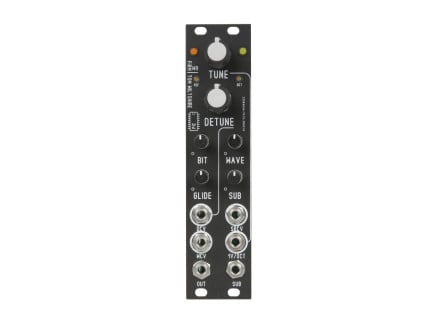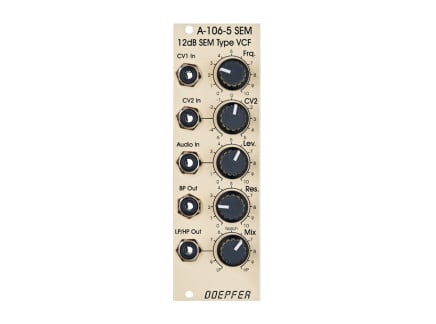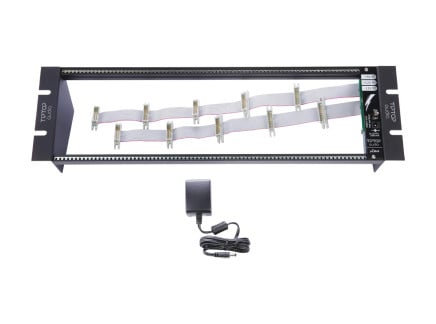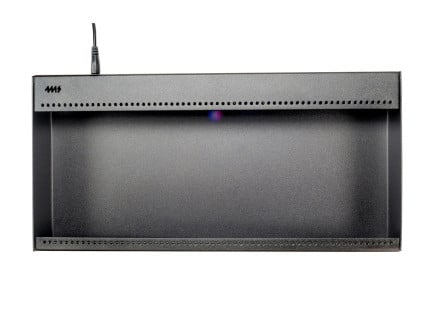Modular synthesis is a complex, yet compelling field—and that means that, while plenty of people are interested to get into modular synths, it's not always obvious how to get into modular synths. Because everyone's musical needs are different from one another, and because modular synths are so personal and customizable, it can be tough to identify the best way to get up and running—and of course, modular synths can be quite expensive, so the price tag compounded with a certain level of mystery is all too often enough to discourage people from dipping their toes in.
But there's good news! In reality, getting started with Eurorack modular synths doesn't have to be complicated, and it doesn't have to be expensive.
We've tackled some basic ideas about what makes modular synths so rad and how you can wrap your head around planning your first Eurorack system before—but in this article, we're following along with some advice from our Patch Pal Wes about how to plan a Eurorack system on a budget. Along the way, we'll talk about ways to think about what modules you need in your setup, we'll dispel some modular myths, and we'll discuss Wes's own crack at an ideal budget Eurorack modular system—so, let's get started.
What are the Different Types of Eurorack Modules?
One of the first hurdles in understanding how to plan your Eurorack system is simply knowing what types of modules you need—but before understanding that, it's important to know what types of modules even exist. Wes breaks it down nicely—basically, there are three main categories that basically every module falls into: sound generators, things that affect different qualities of your sound generators, and modulators.

Sound generators are critical for most modular systems. This is where your sound originates! In most modular synthesizers, the main sound generator is an oscillator: a module that generates constant tones. That said, there are plenty of other types of sound generators out there—noise sources, sample players, drum modules, etc. If you're building a system for the purpose of processing external instruments, you could even use an external input module to cover this category.
The next category of module is modules that affect sound. Again, this is a pretty broad category, including modules like filters, VCAs, delays, reverbs, and so on. Generally speaking, it's very common for even a modest modular system to at least contain a filter and VCA, so these are our first go-to recommendations to fill this category: the filter allows you to shape the raw sound of an oscillator or noise source (or samples or external instruments!), while a VCA gives us the ability to dynamically control the loudness of whatever sound we please...and because timbre and dynamics are, of course, a critical part of most music, these tools are generally wise to include in your system.
The final category of module is modulators: modules that produce variable voltages that allow us to change the behavior of other modules. This category includes things like LFOs, sequencers, envelopes, random voltage generators, etc. Using modulation sources like these, we can cause any aspect of any other type of module to vary over time—you can use a sequencer or LFO to change an oscillator's pitch, or a filter's brightness, or a VCA's loudness, for instance. In fact, you could even use a modulation source to change the speed, intensity, or other characteristics of other modulation sources: there's really no limit to what is possible.
Are there other ways to categorize modules? Yes, absolutely. Are there other types of modules out there? If you want to get technical, yes, probably so—but as a general rule of thumb, having a balanced mix of these three types of modules is an awesome starting point. If you have sound generators, sound processors, and modulators present in your system from the very beginning, you're setting yourself up for success...and you're likely to have a dang good time as you get up and running.
Making it a Reality
Of course, understanding these high-level concepts isn't the same as actually planning a system—so our Patch Pal Wes offered his take on a great system at as low a cost as possible—in fact, his selection of modules (case not included) comes in under $500. As seen in the video above, his system contains the Blue Lantern TW DCO, Doepfer A-106-5 SEM Filter, Super Synthesis TVCA, Super Synthesis PHRSR, and Dreadbox Ataxia. But why these particular modules? Well, let's revisit our main module categories above, shall we?
Sound generators: Wes's system uses the Blue Lantern TW DCO digital oscillator as its primary sound generator. There are plenty of good reasons to pick this particular module: it has a lot of selectable waveshapes (sixteen!), a built-in suboscillator, built-in glide parameter for portamento, and even a quantized 1V/oct input...so it's super easy to get it to produce stable, in-tune melodies. Despite being a single oscillator, all these features add up in such a way that TW DCO can produce a pretty broad range of sounds even on its own.
What about modules to affect the sound? Wes chose the Doepfer A-106-5 SEM Filter as a primary sound shaper: this filter allows for a continuous blend of highpass and lowpass response, a dedicated bandpass output, and multiple CV inputs—and of course, the classic SEM-style topology means that it can do everything from super smooth to outright nasty, snarly alterations to incoming sounds. Likewise, the Super Synthesis TVCA (now discontinued) is a combo VCA + soft clipping distortion module. It's great for typical VCA/gating effects, and can add a wide array of distortion characteristics to your sound. It's awesome either before or after a filter: before a filter, it can provide a lot of edge for the filter to cut out or accentuate, and after a filter, it can be used to add subtle grit to extreme howls to the filter's resonant frequency. Of course, even though TVCA is discontinued, there are plenty of other VCA alternatives out there—for instance, Wavefonix's own VCA module provides great value for the functionality it provides.
And then, there's modulators: in this system, Wes chose the PHRSR and Ataxia. PHRSR is, in my mind, an uncommon but quite excellent recommendation for a beginner system: it's a knob recorder module that provides an easy, intuitive, hands-on, and straight-up fun way of adding modulation to your patches. With up to sixteen steps of knob recording, you can simply grab a knob and record a simple sequence to either of its output channels. It also has a clock output—but it can be clocked by other modules as well, so you can sync it up with the rest of your system however you'd like. Dreadbox's Ataxia is a dual modulation source that tackles some somewhat more conventional modulation duties: it can act as a dual ADSR, function generator, or LFO, granting access to both triggered and continuous types of modulation. Between it and PHRSR, this little system has the ability to pull of an enormous range of modulation tricks—and between one another and the system's sound generators and processors, there are plenty of things to modulate.
Of course, you don't necessarily need to pick these particular modules when planning your first system. The biggest takeaway here is that these are all affordable modules that can each do a lot of interesting things. By packing so much functionality into a small space, this deceptively simple system actually becomes capable of a wide range of musical tasks—and, like the best modular systems often do, it'll keep you excited about the new sonic directions you can go without even needing to add any other modules. If you focus on packing in a lot of options into even a small system, you'll be surprised about how much you can do with relatively few modules.
A Brief Word About Cases
Of course, one of the most important parts of any modular system is its case and power supply. This is how you keep your modules housed and powered, so you want to make sure to get something that you really love and trust. Luckily, there is no shortage of options out there!
For the sake of his demonstration, Wes chose a 4MS Pod case—and generally speaking, these are some of our favorite cases out there in terms of size, reliability, and general value...they're all surprisingly affordable, and easy to take with you wherever you go.
That said, there are plenty of other amazing cases out there from companies like Intellijel, Blackhole Cases, Tall Dog (who make excellent a la carte case options), Tiptop Audio, and more. We dive much more deeply into these topics in our articles about Eurorack case basics and Eurorack power supply basics, so I recommend scoping those out if you're planning out your first system!
Myth Bustin' Pt. 1: Output Modules
One big question we're often asked when people are building out their first modular system: do I need a dedicated output module? Am I going to break anything if I plug my modular system's signals directly into my mixer or audio interface?
In short? No, you don't need an output module, and it's extremely unlikely that you'll break your mixer or interface by plugging a Eurorack output into it. Using dedicated output modules is generally considered a "best practice," in that they do help you to easily and consistently get your signal levels into a solid range for interfacing with other types of gear, and they make it fairly easy to fine-tune your signal levels.
In reality, the worst thing that's likely to happen when sending a modular signal into a mixer or interface is that it'll be much louder than the typical standalone synth, mics, or other instruments—so you may need to use a signal pad, or just reduce the level of your inputs to get things playing nicely. Of course, you could also be intentional about reducing the signal levels coming out of your system too: use an attenuator or a VCA to keep your signal levels in check before they even get to your external gear and you'll be in fine shape. Again, it's slightly more fool-proof to use an output module...but we don't think that's a critical piece of the puzzle in order for you to get started building a system. (A side note—I didn't even own a dedicated output module until like, eight or so years into owning a modular system!)
Myth Bustin' Pt. 2: It's All Gotta Be Modular
Okay, so we feel pretty strongly about this point, so if you don't take anything else away from this article, please give this some thought: if you're working with modular gear, you don't need to exclusively work with modular gear. In some corners of the synth world (perhaps corners that you've been to?), there's an attitude that doing absolutely everything 100% with a modular synthesizer is the "best" way or "purest" way to do things—but we don't believe that to be universally true. In fact, we think of modularity as an approach that can apply to all types of gear: use what pieces work for you, and find a way to connect them together. If that means that you work best when you go all modular, that's great—but many of us on Perfect Circuit's staff find that we work best when we use different types of gear in conjunction with one another.
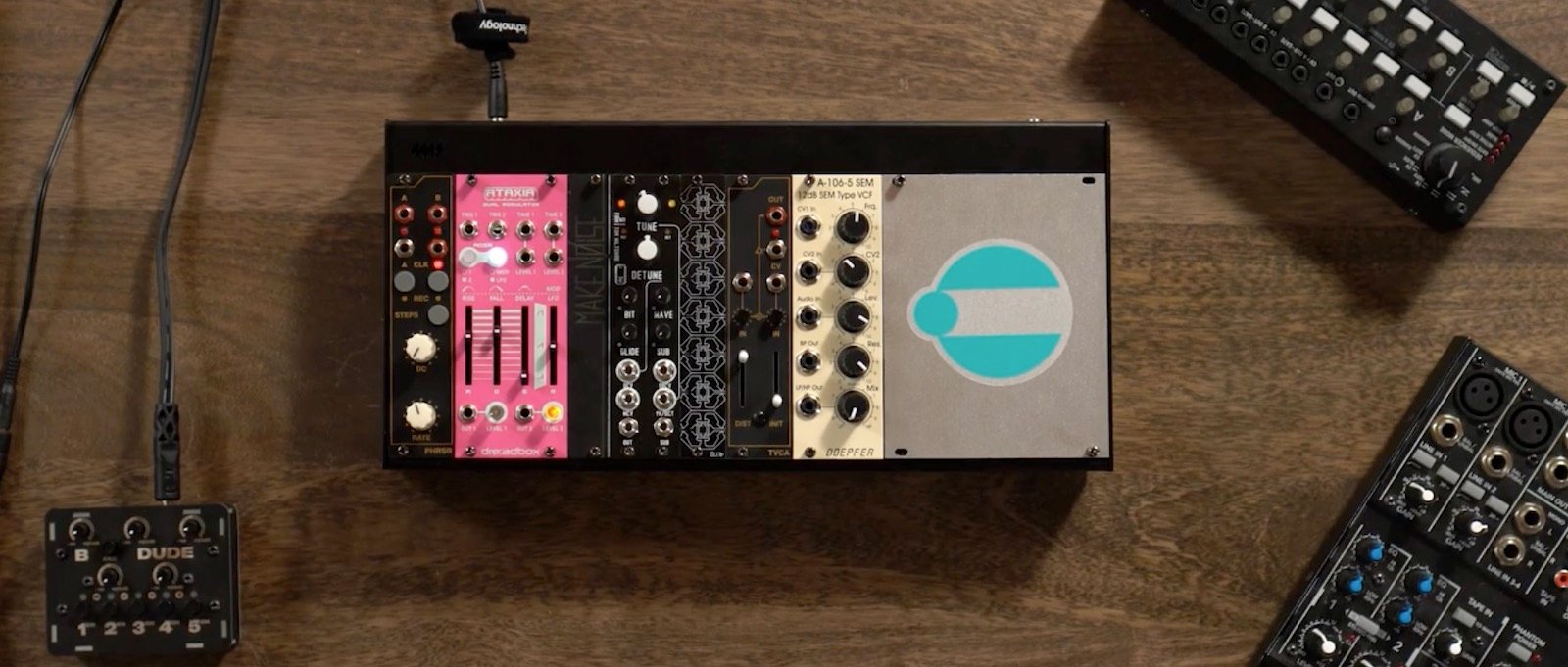
Take Wes's setup, for instance. Sure, it can work as a self-contained instrument...but it also works great with external controllers, as he demonstrates with the Keystep and SQ-1. Odds are, if you're a musician who's been into gear for a while, you probably have loads of stuff around that you can use in conjunction with a modular system: you might have MIDI controllers, sequencers, effects pedals, tape recorders, external instruments...and every single one of these things are compatible with one another. When you start building a modular synthesizer, it doesn't mean that you need to completely wipe your slate clean and abandon the things you already own, or that you need to completely rethink the way that you make music. A modular synth doesn't need to be the whole of your musical practice: it's just another tool in the arsenal, helping you toward the goal of having fun making sound.
Bringing It All Together
In Wes's video, he shows how a humble, budget-conscious modular system can be used to do everything from insane drones to twinkling arpeggios, catchy sequences, and more—and while he did plan an awesome system, it's important to remember that the most important thing about modular synthesis is that it's highly personal. His proposed system may or may not be the perfect instrument for you, but odds are that there's a way to build your own ideal synthesizer on a relatively modest budget.
So to recap, what do you need to keep in mind when planning your Eurorack system? Try to keep a good balance of sound generators, sound modifiers, and modulators. At least at first, try to make each module as multi-functional as you can. Find a case that suits your budget and ideal form factor. Don't worry too much about getting an output module right away. And perhaps most importantly—don't fret about making the modular your sole musical tool if you've already got a good thing going with other workflows or other gear. If the idea of working purely with modular is inspiring for you, then go for it—but if that seems daunting, or if you're looking to expand an existing setup, remember that there's almost always a way to leverage your current toolset and skillset to bring the modular synth into what you're already good at.
Again, there's no shortage of ways to think about how to plan a modular system, but these are tips and ideas that we keep coming back to. Who knows...perhaps we'll return with some more perspectives in the future!

